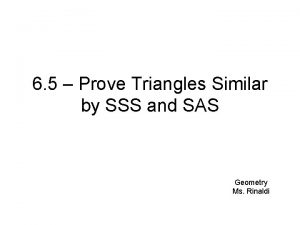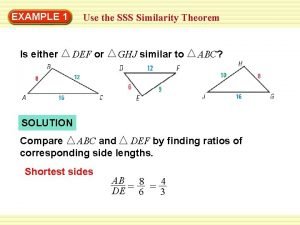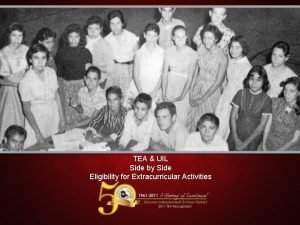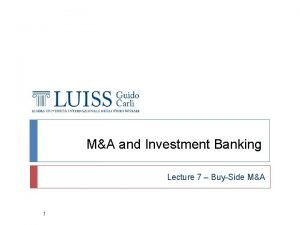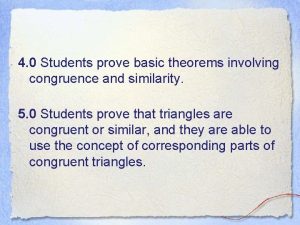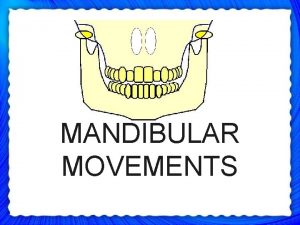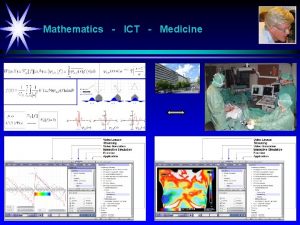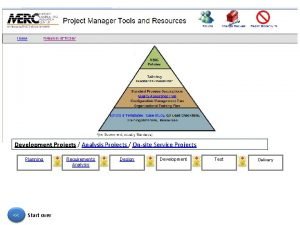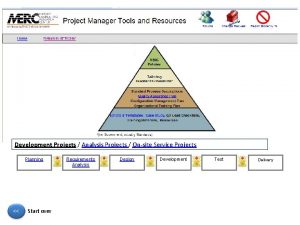Leading Projects The Human Side of Project Management








































- Slides: 40

Leading Projects: The Human Side of Project Management Developing Self - Awareness 1

A Hierarchy of Personal Life-Management Skills Symptom Tactical Stress Management Time Management Priority and Goal Setting Self Awareness Problem © Peter Dominick, Michael R. Ryan 2007 Strategic 2

The Enigma Self Awareness v Individuals both seek for and avoid self understanding. § § A prerequisite for management success and personal insight People often avoid self awareness because they feel they might learn something unpleasant about themselves 3

Appreciating Individual Differences A whale is as a unique as a cactus but don’t ask a whale to survive Death Valley. We all have special gifts. Where we use them and how determines whether we attain our potential [and are happy]. Max De. Pree The network of positions and roles that define the formal organization is occupied by people who put their own personalities into getting the job done. Not only does each person have a certain style of doing his own work, but he has a unique way of relating to others… Edgar Schein To know won self is wisdom, but to know one’s neighbor is genius. Minna Antrium

What do you see? • Do you see an old lady? • Do you see a young lady? • Can you see both an old lady and a young lady? 5

Self Awareness v Information that crosses the sensitive line is resisted and, in fact creates rigidity and defensiveness. § Discrepant information: u u does not create rigidity when it is verifiable, predictable, and controllable is less threatening when self-disclosure occurs, and when others help explain or interpret the information 6

Five Core Aspects of Self-Awareness PERSONAL VALUES Determine personal standards and moral judgment EMOTIONAL INTELLIGENCE Manage self and relationship with others ORIENTATION TOWARDS CHANGE Determine adaptability and responsibility LEARNING STYLE Determines information acquisition & evaluation CORE SELF-EVALUATION Determine preferences & interaction patterns 7

Attitude Toward Change: Two Dimensions v Tolerance of ambiguity § § v Locus of control § v Ability to cope well with new situations Ability to cope with situations where information is incomplete or uncertain Extent individuals attribute causation to factors they can control (internal) versus those they can not control (external) High tolerance for ambiguity and internal locus of control are associated with managerial success 8

Ambiguity Scale Comparison Data SAMPLE SCORE NUMBER MEAN Stevens PM Students 200 53. 6 New York Psychology Students 50 50. 9 New York Evening Students 57 53. 0 41 43. 3 58 48. 9 Advanced Sociology Students 33 49. 3 Nursing Students 34 51. 9 High School Honor Students 62 48. 2 Eastern Medical Students 229 44. 6 Midwestern Medical Students 249 45. 2 Private Women’s College Students Engineering Students 9

Locus of Control Scale Comparison Data SAMPLE SCORE NUMBER MEAN 204 5. 6 50** 6. 24 71*** 261*** 8. 29 303* 3. 88 National High School Sample 1000* 8. 50 Ohio State Psychology Students 1180* 8. 29 Peace Corps Trainees 155* 5. 94 Stevens PM Students Alberta Municipal Administrators Business Executives Career Military Officers Connecticut Psychology Students 10 Sources: *Rotter, 1966; **Harvey, 1971; ***Rothberg,

Interpersonal Orientation v Consists of three needs people have when interacting with one another § § § v Inclusion To include others or to be included by them Control To control or be controlled by others Affection Express warmth and closeness to others; receive warmth and closeness from others Three incompatibilities can exist among these three needs § Reciprocal; Originator; Interchange 11

FIRO-B Scales & Dimensions Inclusion Control Affection Expressed How much do you try to be How much do you try to close to people? What is your include others in activities? exert control and influence, level of comfort in expressing (e. I) and direct others? (e. C) personal feelings and supportiveness? (e. A) Wanted How much do you want others to include you in activities? How much do you want others to invite you to belong? (w. I) v How strong is your need to be in well-defined situations? To what degree do you want others to take control? (w. C) How much warmth do you want from others? What is your level of enjoyment when people share feelings, and when they do encourage efforts? (w. A) FIRO-B Results: are numerical scores from 0 -9 in each of the six categories of need listed above. • Score Range: 0 -2 – Low preference/need • Score Range: 3 -6 - Moderate preference/need • Score Range: 7 -9 – High preference/need 14

FIRO-B Analyzing your scores Inclusion Expressed Toward others 7 Wanted Behavior from 6 others Totals 13 Control 4 Affection Totals 6 3 17 7 7 16 13 33 Can compare expressed total with your wanted total: the extent you are willing to give as much behavior as you receive. 15

FIRO-B Analyzing your scores Inclusion Expressed Toward others 7 Wanted Behavior from 2 others Totals 9 Control 4 3 7 Affection Totals 6 17 2 7 8 Controllers – high expressed score low wanted score. Only want to give less willing to accept 16 24

FIRO-B Analyzing your scores Inclusion Expressed Toward others 3 Wanted Behavior from 6 others Totals 9 Control 4 Affection Totals 3 3 10 7 7 16 10 Passive – Low expressed score high wanted score. Only want to receive don’t initiate interaction 17 25

FIRO-B Analyzing your scores Inclusion Expressed Toward others 7 Wanted Behavior from 6 others Totals 13 Control 4 Affection Totals 6 3 17 7 7 16 13 33 Another way to look at the data, is comparing your scores on one need. Highest scores may indicate? 18

Average FIRO-B Scores and Ranges (General Population) INCLUSION CONTROL AFFECTION ROW TOTALS Expressed Toward Others 4 to 7 5. 4 2 to 5 3. 9 3 to 6 4. 1 9 to 18 13. 4 Wanted From Others 5 to 8 6. 5 3 to 6 4. 6 11 to 20 15. 9 Column Totals 9 to 15 11. 9 5 to 11 8. 5 6 to 12 8. 9 20 to 38 29. 3 19

Average FIRO-B Scores and Ranges (Stevens PM Students) INCLUSION CONTROL AFFECTION ROW TOTALS Expressed Toward Others 4. 62 3. 99 13. 21 Wanted From Others 4. 67 3. 61 5. 44 13. 72 Column Totals 9. 27 8. 23 9. 43 26. 93 20 n=199

FIRO-B Compatibility Scores v Matching one person’s score with another's § § Reciprocal One person’s expressed to Another’s wanted Originator Match between both parties expressed scores Interchange Extent parties emphasize same or different needs Total Sum of Absolute Values for all values 21

FIRO-B Matching one person’s scores with another’s Inclusion Person A Expressed Toward others 8 Wanted Behavior from others 2 Difference between one person’s expressed behavior and the other person’s wanted behavior. Person A (e. g. , manager) has high need for inclusion Person B (e. g. , report) is low on this need Reciprocal incompatibility is > than 6 in absoluter values. 23

FIRO-B- IT Member Sample Results v Table below shows the interpersonal needs most common in the IT Sample: § Moderate expressed inclusion - 59% reported a moderate need/interest in inviting others to participate in their activities. § Low wanted inclusion - 55% report little need to be invited to participate in others' activities. § Low expressed and wanted control - almost half of the sample reported little interest in controlling other's activities, however, there is also little interest in allowing others to take control. § Moderate expressed and wanted affection - In the most evenly distributed scale, more than 50% of the respondents want feedback/support some of the time, but at other times, the need is less great.

FIRO-B - Affection Preliminary Interpretations v Affection relates to a person’s needs for feedback and acceptance. v Of the three scales, this is most evenly distributed, suggesting that the need for affection is generally variable, and may often be based upon the situation at hand. v Wanted Affection scores are slightly higher than Expressed, suggesting that those in the sample are slightly more likely to want feedback than to offer it to others.

FIRO-B Applications for IT Teams v v v The strength of the FIRO-B comes from the questions it raises for a team & the resulting learning process. Posting team FIRO-B scores and discussing may provide a useful language for talking about issues of inclusion, affection & control. Example from a Study Team: § § Manager with high Inclusion and Affection needs was frustrated by the fact that her team rarely gave her feedback about the project, even when she asked for it during team meetings, which she held frequently. She was also concerned by the lack of social connection present among team members. Workshop revealed that her team had collectively low FIRO-B scores. They, too, were frustrated - because there were too many meetings, and the Manager seemed too focused on “group sharing. ” Despite the “group sharing” aspect of the workshop, posting and discussing MBTI and FIRO-B scores gave this team a new language to use to discuss their frustrations. Seeing the differences between the Manager and the team helped the group identify specific sources of conflict. Ultimately, the team established new ground rules related to communication pathways and frequency, which were designed to meet the needs of both the Manager and the team members.

Values: Two main types v Instrumental values: the means and modes of v Terminal values: ends or desirable goals v Managers should hold five values more centrally than other people conduct u u u Sense of accomplishment (T) Self-respect (T) Comfortable life (T) Independence (I) Ambition (I) 29

Instrumental Values v Instrumental values are associated with levels of moral maturity or values development which change as we age and mature § Self-centered level u § Conformity level u § Values and moral judgment are based on needs, wants and the consequences of an act Values and moral judgment are based on conformity to expectations and conventions Principled level u Values and moral judgment are based on Internalized set of principles 30

Ethical Behavior v Individuals who have developed to a more mature stage of value development behave more responsibly and ethically v Ethical behavior is based on one of the following u Universalism u Reversibility u Dignity and liberty u Utilitarianism u Distributive justice u Personal moral code

Core Self-Evaluation Personality: The relatively enduring traits that makes an individual unique.

Determinants of Personality v Some of our personality may be attributed to biology and genetics v However, people can make changes to their personality if they are determined

Personality Traits The Big Five Dimensions of Personality 1. Extraversion 2. Agreeableness 3. Conscientiousness 4. Neuroticism 5. Openness

The Five Factor Model v Extroversionintroversion § § v Agreeableness § § v sociable, talkative, assertive, active retiring, sober, reserved, cautious good-natured, gentle, cooperative, forgiving, hopeful irritable, ruthless, suspicious, uncooperative, inflexible Conscientiousness § § careful, thorough, responsible, organized, self-disciplined, scrupulous irresponsible, disorganized, undisciplined, unscrupulous

The Five Factor Model v v Emotional Stability § calm, enthusiastic, poised, secure § depressed, angry, emotional, insecure § (unstable = Neurotic) Openness to Experience § imaginative, sensitive, intellectual, polished § down to earth, insensitive, narrow, crude, simple

Core Self-Evaluation Four Components 1. Self-Esteem 2. Generalized Self-Efficacy 3. Neuroticism 4. Locus of Control

Self-Efficacy v Albert Bandura’s pioneering work v belief in one’s own capacity to perform a task v develops in two ways § direct experiences - feedback from task performance § vicarious experiences - observations of others’ performing tasks

People make judgments about whether they can perform a task effectively v analyze the task v assess how their resources and constraints will help or hinder v assess past outcomes in terms of their ability and skill (internal) or external forces v higher self efficacy will result in more challenging and difficult goals

The Effects of Core Self-Evaluations

Satisfaction with Self-Awareness Scores Very Satisfied Neutral Very Dissatisfied 1 Values 2 Cognitive Style 3 LOC 45 4 Ambiguity 5 6 FIRO-B PSI

Group discussion Respond to the first five statements on page 93 in Whetton and 1 of the statements on page 94 u u u v v In taking the assessment instruments, I was surprised by… Some of my dominant characteristics captured by the instruments are… Among my greatest strengths are…. Among my greatest weaknesses are. . . The time I felt most successful was when… Using your FIRO-B results, calculate Reciprocity scores for all pairs of individuals in your group. For each pairing you will get three Reciprocity scores, one for each need (See page handout) Based upon your scores on the assessment instruments u u u Describe some collective strengths Describe some collective weaknesses Describe some ways you complement one another

Looking Glass Exercise 1. In the assigned groups share your scores on the skill assessment exercises 2. To help articulate your self awareness, each member should take turns going first in completing first 5 statements and at least 1 of the next 6 aloud on page 94. 3. After each person has answered all the questions, partners should provide reaction and feedback a. What I have learned about you … b. I think your greatest strengths are … c. Areas I think you may want to work on … 4. The exercise should be an interchange not a one way presentation § How difficult was it to provide feedback to others after they answered the questions? § Self-disclosure is important in acquiring self awareness; what else could have been shared to improve your self-awareness?

Cognitive Style Summary Characteristics The Major Focus of Each Cognitive Style Sensing Intuitive Concrete experience; Details; Concepts; Relationships; The Parts of the whole; Facts; Close whole; Theories; Generalizations; Commonalities; What is similar examination; Uniqueness; What doesn’t fit Thinking A plan; A method; Rational procedures; Logical progression; Justifying the means; Empirical procedures Feeling Gut feel; Internal senses; Subjective states; Impressionistic data; Irrationality; Spirituality

Cognitive Style Instrument Comparison Data COGNITIVE DIMENSIONS Intuitive Sensing Thinking Feeling Males Females 5. 98 6. 02 6. 80 5. 20 6. 04 5. 96 6. 94 5. 06 Accounting 6. 70 5. 30 6. 40 5. 60 Business 7. 56 4. 44 7. 67 4. 33 Engineering 4. 57 7. 43 9. 14 2. 86 Liberal Arts 7. 33 4. 67 6. 67 5. 33 Nonbusiness 6. 00 5. 75 6. 25 Combined 6. 00 6. 84 5. 16 50 Comparisons are based on the scores of 408 graduate and undergraduate college students.
 How to prove triangles similar
How to prove triangles similar Similar picture
Similar picture Sss similarity examples
Sss similarity examples Side side side similarity postulate
Side side side similarity postulate Project management chapter 4
Project management chapter 4 Human side of project management
Human side of project management Bobbin leading and flyer leading
Bobbin leading and flyer leading Managing and leading software projects
Managing and leading software projects Project portfolio matrix dimensions
Project portfolio matrix dimensions Digitization workflow
Digitization workflow Introduction to software project management
Introduction to software project management Projects abroad human rights office
Projects abroad human rights office Perfect competition side by side graphs
Perfect competition side by side graphs Tea uil side by side
Tea uil side by side M&a process timeline
M&a process timeline Soda lime uses
Soda lime uses Smtyk
Smtyk Two wheels roll side by side
Two wheels roll side by side Weld symbols with examples
Weld symbols with examples A regular pentagon of 30mm sides is resting on hp
A regular pentagon of 30mm sides is resting on hp Indications of monoplane occlusion
Indications of monoplane occlusion Melkgeschirr aufbau
Melkgeschirr aufbau Side by side stuff
Side by side stuff Sine and cosine law
Sine and cosine law Client side and server side
Client side and server side Posselt's diagram
Posselt's diagram Videocon side by side refrigerator
Videocon side by side refrigerator Red side blue side
Red side blue side Telecommunications project management
Telecommunications project management Cost management in agile projects
Cost management in agile projects Resource histogram vs responsibility assignment matrix
Resource histogram vs responsibility assignment matrix Project management human resources
Project management human resources Project human resource management pmbok ppt
Project human resource management pmbok ppt Project human resource management pmbok
Project human resource management pmbok Human resource management system project
Human resource management system project The role of project management in achieving project success
The role of project management in achieving project success Modern project profiles in spm
Modern project profiles in spm Project cost duration graph
Project cost duration graph Modern project management began with what project
Modern project management began with what project Software project evaluation
Software project evaluation Perpetual project closure
Perpetual project closure
